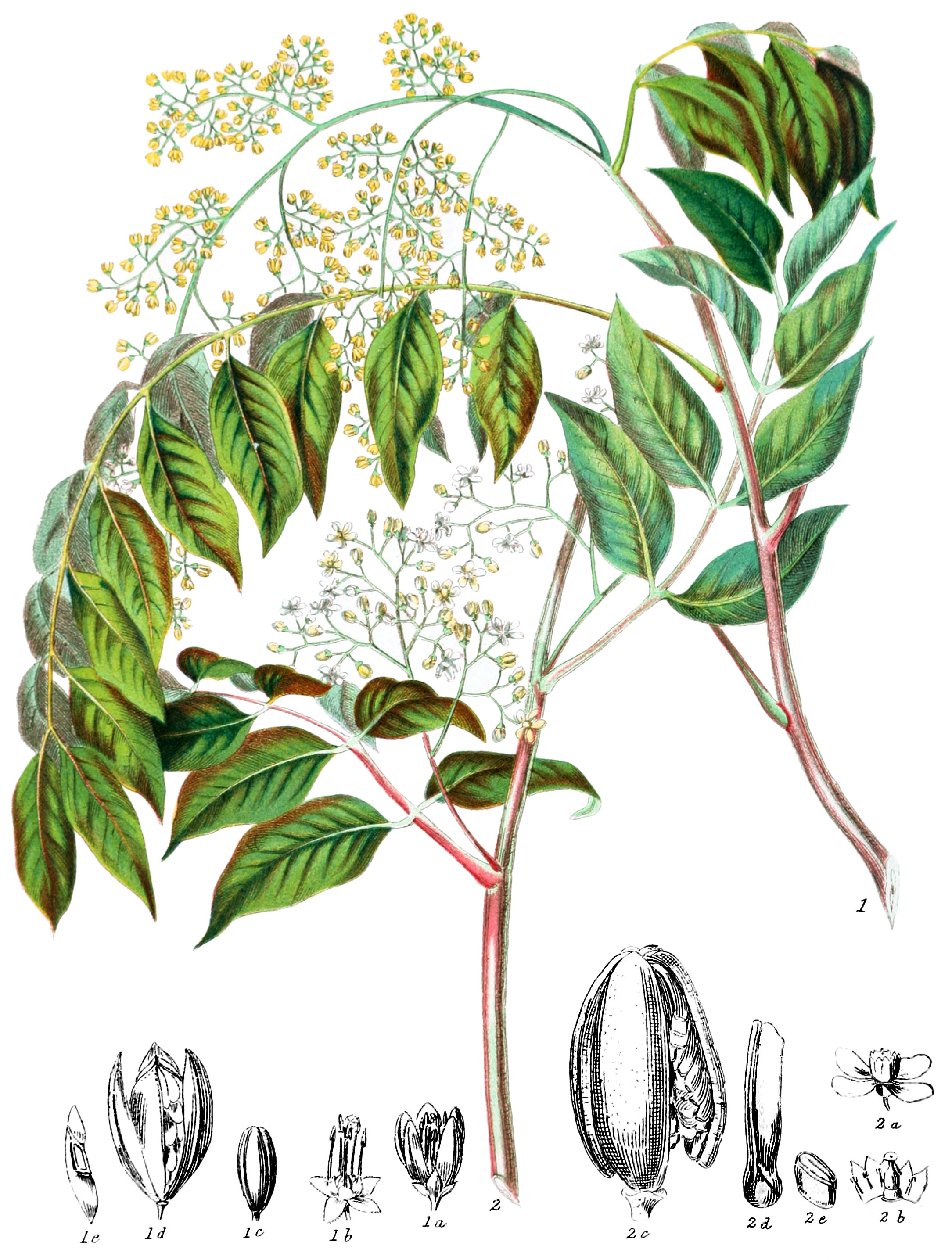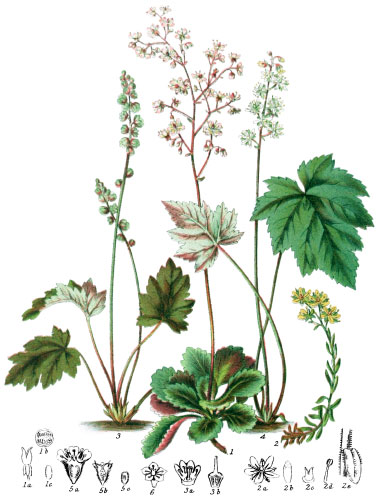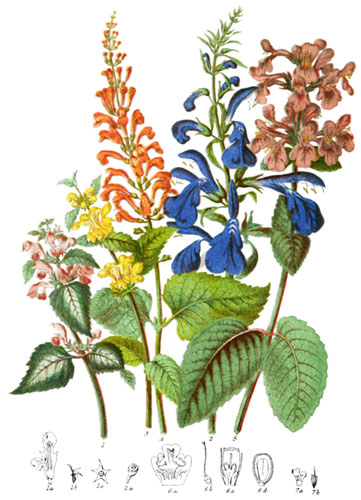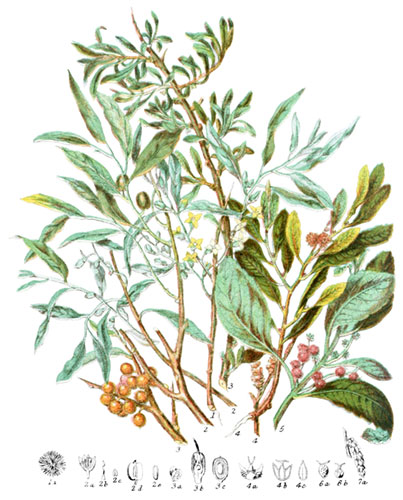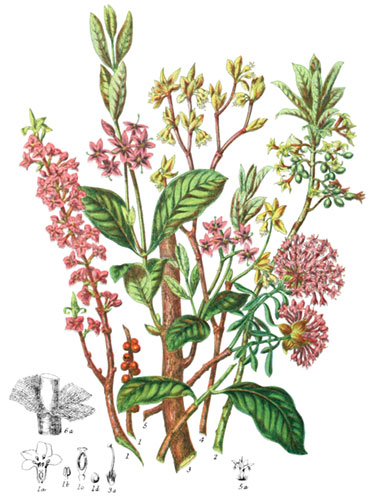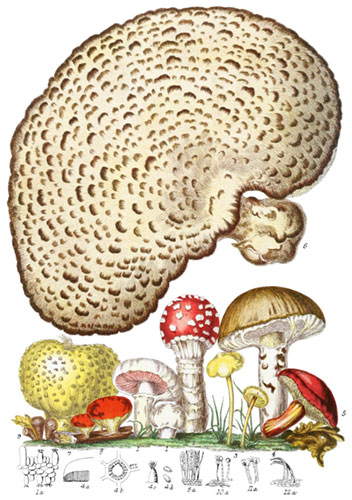Key characteristics
Trees with a compact wood, usually sweet-scented, and finely veined. The leaves are alternate, pinnated, without stipules. The flowers are minute, growing on branching stalks, terminal, or from the base of the leaf-stalks: the calyx is four or five-cleft, the petals four or five. The stamens are from eight to ten, distinct, and fixed in honey-glands in Cedrela, united within a tubular nectary cup in Swietenia, inserted into a dis at the base of the ovary. The style and stigmas are simple. the cells of the ovary are equal in number to the petals, or fewer. The fruit is a capsule, with valves separable from the thick axis, splitting from the top in Cedrela, from the base in Swietenia. The seeds are flat, winged, placed in two rows on the valves, having thin albumen or none.
These trees have a close affinity with Meliaceæ, but are distinguished by their winged seeds: Flindersia and Chloroxylon, having their leaves dotted with pellucid glands, form a link with the Orange tribe.
Fragrant, close-grained, and astringent bark, are the two chief properties of this tribe.
Select plants in this order
Not all plants listed are illustrated and not all plants illustrated are listed.
- Cedrela is a genus of trees remarkable for the length of the pinnated leaves; those of C. serrata, in the valleys of the Himalaya, have eighteen pair of leaflets, the whole being nearly three feet long, drooping in a graeful form; the flower-branches exceed them in length. The bark, leaves, and fruit have usually a disagreeable scent, but the wood is fragrant.
- Cedrela Toona (1), the Mahogany tree of India, has an erect trunk, attaining great height in favourable localities in Bengal; the light wood is extensively used for furniture throughout the Indian provinces, the trees being scattered widely as far as the base of the Himalaya. The leaves come forth with the flowers in February, and the seeds ripen in May; the astringent bark is employed as a remedy in fever.
- The bark of C. febrifuga is considered medicinal in Java.
- The young shoots of C. augustifolia are said to have a strong smell of garlic.
- C. odorata, having an extremely straight stem and a soft wood, furnishes canoes for the colony of Demerara: the Warani Indians, who inhabit the swamps between the rivers in the Delta of the Orinoco, are very expert in hollowing them out, frequently obtaining a canoe forty feet in length and six in width.
- One species of Cedrela grows in the vicinity of Pekin.
- Swietenia Mahogani (2) was named by Jacquin, in honour of Gerard von Swieten, who, by command of the Empress Maria Theresa, formed the Botanic Garden at Vienna. Ever since its introduction into Europe in 1724, it has been esteemed the most valuable timber-tree for various kinds of furniture, being of extreme durability, and capable of the finest polish; the wood of the branches is usually selected for ornamental small objects, on account of the beauty of the veining. The trees abounded formerly in the forests of Jamaica, and are still used there for beams and planks requiring strength; they are found also in St. Domingo, Honduras, and other parts of the West Indies. The Honduras Mahogany is not so highly valued in general as that of Jamaica, but the wavy veining and the brighter colour are very beautiful for some purposes, particularly for pianofortes; the value of a single tree is sometimes as high as 2000l. The felling of the trees constitutes the chief occupation of the natives, who are able to recognise them by the colour of the withering leaves in autumn at a great distance. After having collected a sufficient store, and conveyed them with much labour to the rivers, they are floated down to the coast for embarkation in ships.
- S. febrifuga of the East Indies affords a durable wood for the Hindoo templates: the bark yields a red dye.
- Soymida febrifuga, the Rohuna of Hindostan, and the Red-wood of Coromandel, is a valuable tonic in fever in India.
- The bark of Chickrassia tabularis is astringent without bitterness.
- Chloroxylon Swietenia is one of the trees which produces wood-oil in India, and is well-known satin-wood of cabinet-makers.
- Oxleya xanthoxyla is a large tree in the New South Wales, called by the natives yellow-wood.
- The Khaya* of Senegal, the common febrifuge in the fevers of the Gambia river, belongs also to this tribe.
- Flindersia of New Holland and Amboyna, and Chloroxylon of the East Indies, differ from the rest of these trees in having transparent glands in the leaves, containing essential oil.
Locations
The trees of this Tribe are common in the tropical regions of America and India. Cedrela and Swietenia grow on the Andes at an elevation of 1500 feet: they are rare in Africa and the adjoining islands.
Legend
- Cedrela Toona, Indian Mahogany-Tree. East Indies.
- Flower, magnified.
- Without the petals.
- Seed-vessel.
- Open, magnified.
- Seed.
- Swietenia Mahogani, Mahogany-Tree. West Indies.
- Flower, magnified.
- Stamens and Pistil.
- Seed-vessel.
- Seed.
- Section.
*Khaya was spelled as “Khlaya” in the original description.
Explore more
Posters
Decorate your walls with colorful detailed posters based on Elizabeth Twining’s beautiful two-volume set from 1868.
Puzzles
Challenge yourself or someone else to assemble a puzzle of all 160 botanical illustrations.
